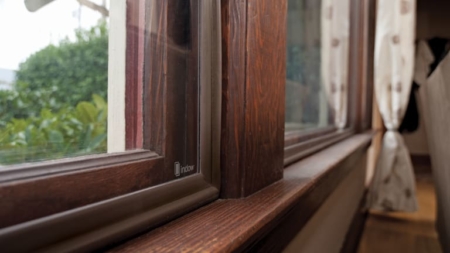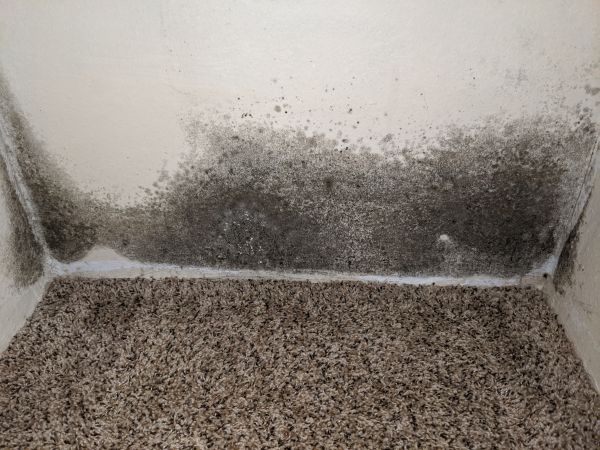Insulation is a crucial component of energy efficient buildings. It helps keep buildings cool in the summer and warm in the winter. According to Oak Ridge National Laboratory, heating and cooling costs are 50-70% of energy use for the average household in the U.S. The effectiveness of insulation is measured by the ability of the material to resist the transmission of heat. This is called R-value. Higher R-value insulation has a better ability to reduce heat loss in the colder late fall and winter months.
Picking insulation for a building project can depend on where the insulation will be used (interior, exterior, basement, attic, storage shed, etc), whether the building is single-level or multi-level, how the building is heated and cooled (central air, wood stove, furnace, etc), climate/moisture of the area (Portland is known for being damp most of the year), and product availability. Fiberglass and other man-made materials are an option, as described in our 2011 article about insulation. Fiberglass insulation has an R-value of 3.0 to 4.0 per inch and is estimated to be in 90% of homes in the U.S., however it can cause irritation upon contact with skin and the long-term effects of breathing in fiberglass bits are not fully known yet. There are also several environmentally friendly insulation choices, including a few very new options:
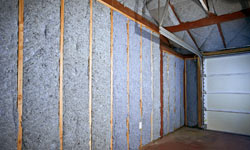
Ultra Touch Denim insulation
Cotton is largely made from at least 70% recycled material, such as denim. Unlike fiberglass, it is free of formaldehyde, but offers the same insulation performance of fiberglass. Cotton is safe to handle and offers superior acoustic qualities. It has treated with non-toxic boron and has no effect on indoor air quality. A disadvantage is that it can absorb moisture, plus it costs about twice as much as fiberglass, but the longevity and sturdiness of cotton can make it worth the extra cost. Cotton is available in both loose fill and batt insulation.
Cellulose is made from wood products and is at least 75% post-consumer recycled content. A majority of cellulose comes from recycled newspapers and is available as loose fill. Advantages include using less energy to produce compared to fiberglass and no harmful effect on indoor air quality (it is treated with non-toxic borate). A disadvantage to cellulose is that it can absorb moisture. It is best suited for parts of a building with very low to no moisture, such as attic floors and wall cavities. Cellulose is usually blown into walls and can settle if sprayed in dry. However, it may be an option to spray it in while damp and that can prevent gaps and settling.
Wool from a sheep is safe to handle, easy to install, and can absorb and release moisture without reducing thermal performance. When wool fibers are compressed, they form millions of tiny air pockets which help to trap air and therefore keep homes warm in the winter and cool in the summer. Wool insulation is non-combustible, therefore it can help slow the development of a fire in the home. A 24-inch roll of R-13 wool insulation costs around $60.
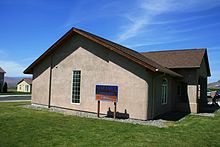
Straw Bale Library
Straw bale insulation can be used for walls that are typically at least 18” thick. The straw comes from the leftover stalk after the edible part of grains (wheat, rice, rye, and oats) are harvested. Straw bale walls are actually flame-retardant because the bales are dense enough to just smolder when the ignition source is removed. Straw bale can have insulation values of R-30 to R-35 or more. Additional advantages include biodegradability and environmentally sustainable. A disadvantage is that straw needs to be kept as dry as possible during the construction process. If kept away from moisture within the walls, straw can last a very long time.
Aerogel is made by removing the liquid from silica under high pressure and temperature. The result is a light-weight material that is more than 90% air. Aerogel has an R-value of 10.3 per inch of thickness and comes in sheets that can be easily tacked on to the studs in a wall. An advantage is the ease of installation, such as one type that has a peel and stick backing. A disadvantage is the high cost (up to $2 per foot), although the high R-value can make the cost of heating and cooling in a building much lower in the long run.
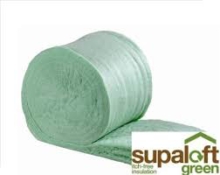
Supaloft Green
Recycled polyester insulation is 90% made from plastic bottles. Supaloft Green is a sustainable insulation quilt made in the United Kingdom.
Cork can be used for more than floors, walls, and wine bottles. It is a flexible material that also works as insulation. Cork granules are sold in bags. An advantage is that they work well for awkward gaps or odd joist spacing. A disadvantage is that the loose granules tend to be less than ideal for drafty spaces. Cork works well for places like cellars.
Icynene is a spray-on foam insulation made from castor oil. It has the thickness of paint when being sprayed on, although it expands about 100 times its volume after making contact with the surface. It creates a thick blanket of insulation that looks similar to the top of lemon meringue pie and has an R-value of 3.6 per inch of thickness. It traps air in tiny bubbles during the foaming process, therefore it tightly seals air leaks, muffles noise, and is mold-resistant. A disadvantage is that it costs about 3 times more than fiberglass. It also requires a ventilation system to be installed because it seals buildings very tightly. In colder climates, the ventilation system should include an air exchanger to warm the incoming air.

Mushroom insulation
Mushrooms, specifically mycellium (mushroom roots), are a newer insulation option. Mycellium grows and bonds agricultural products like corn stalks together. It takes only a few days for the mycellium to grow enough to fill the space in a wall mold or directly between the walls themselves. In 3-4 weeks, it becomes a solid mass that cures to airtight insulation. The final result is strong enough to even replace some building materials, such as studs, which can reduce overall construction costs. Mycellium insulation is fire-resistant, free of chemicals, and completely biodegradable. Ecovative Designs has built a mushroom tiny house.
To learn more about insulation, R-values, and what type of insulation might work best for particular regions of the US as well as areas of a building, energy.gov has some helpful information. Additional info about recommended R-values and insulation for retrofitting existing wood-framed buildings can be found at energystar.gov. For info tailored to an individual building, the online Home Energy Saver tool can help.


